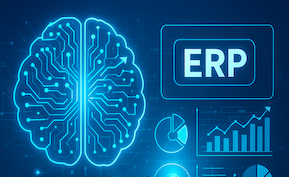Accounting
Artificial Intelligence
Generative AI in Invoice Generation and Customer Follow-Ups

Generative AI is reshaping invoicing and customer communication, shifting from static templates to dynamic, context-aware messaging. From creating personalized invoices to drafting polite but firm follow-up reminders, AI is streamlining accounts receivable while preserving client relationships.
From Templates to Generative AI
Traditional invoicing tools rely on static templates, leaving accountants and small business owners to manually edit tone, payment terms, or follow-up language. Generative AI takes this further by producing invoice drafts and reminders tailored to client behavior, payment history, and even regional communication norms. The result is reduced manual effort, faster cash collections, and messages that feel more human than automated.
AI-Powered Invoice Drafting
Modern AR platforms use generative AI to automatically draft invoices based on billing schedules, prior transactions, and project milestones. Instead of copying line items from past invoices, the system generates:
- Pre-filled details: Line items, taxes, discounts, and project references pulled from contracts, ERP, or timesheets.
- Dynamic payment terms: AI suggests early-payment incentives or adjusted terms depending on customer risk scores.
- Natural-language notes: Customized memos explaining charges in plain language, reducing disputes and back-and-forth.
Generative Reminders & Follow-Ups
Chasing overdue payments can be awkward. AI helps by generating reminder emails that balance firmness with professionalism, while adapting tone to each client’s payment behavior:
- Polite nudges: For customers who usually pay on time, reminders emphasize courtesy and offer quick-pay links.
- Stronger language: For repeat late-payers, AI generates firmer messages, referencing past delays and highlighting due dates.
- Escalation paths: Drafts can escalate from friendly reminders to final notices, ensuring consistency without manual rewrites.
Customization by Client History
The real advantage lies in tailoring communication per client. Generative AI models leverage historical data to produce messages that resonate:
- Payment patterns: If a client typically pays five days late, reminders can be timed earlier with softer phrasing.
- Industry tone: Creative agencies may respond better to conversational notes, while manufacturing clients may prefer formal, compliance-heavy language.
- Preferred channels: Some tools even suggest whether to send a reminder via email, SMS, or client portal notifications.
How the Systems Learn
Generative invoice tools improve with usage. Each sent or edited draft becomes training feedback, refining tone and accuracy. Over time, the AI can adapt to:
- Common dispute causes (e.g., misapplied taxes, missing PO numbers) and preemptively clarify them.
- Response rates to different reminder styles, suggesting which approach accelerates payment.
- Localization—using currency symbols, date formats, and phrasing that fit the client’s region.
Buyer’s Checklist
- ERP/GL integrations: Ensure the tool connects with your accounting platform (QuickBooks, Xero, NetSuite, Sage).
- Language controls: Ability to adjust tone presets—casual, professional, or firm—to fit your brand voice.
- Human-in-the-loop: Review workflows so finance teams can approve AI-generated drafts before sending.
- Audit trail: Logs of invoice and reminder versions to satisfy compliance and audit requests.
- Analytics: Metrics on days sales outstanding (DSO), reminder effectiveness, and payment speed improvements.
Implementation Best Practices
- Pilot with a small client group: Test AI-generated invoices and reminders on a segment before scaling.
- Set tone guidelines: Define company-approved styles for different client tiers to avoid brand inconsistencies.
- Automate gradually: Start with drafts that require approval; move to auto-send once accuracy and tone are trusted.
- Monitor impact: Track collection speed, dispute frequency, and customer feedback to fine-tune usage.
Where Generative AI Excels (and Where It Struggles)
- Strengths: Personalization at scale, consistent escalation workflows, and reducing time spent drafting emails.
- Limitations: May misinterpret edge cases (e.g., partial payments, credits, or complex milestone billing) without proper oversight.
- Human judgment needed: For sensitive accounts or high-value clients, manual review of AI drafts remains essential.
ROI Snapshot
Businesses adopting generative AI in invoicing often report a 10–20% improvement in DSO and a 30–50% reduction in staff time spent on reminders. More importantly, personalized communication helps preserve customer relationships while maintaining cash flow.
Bottom Line
Generative AI is elevating invoice generation and customer follow-ups from repetitive, transactional tasks to personalized, relationship-driven workflows. For finance teams looking to speed up collections without alienating clients, AI-powered invoicing tools are fast becoming an essential upgrade.






